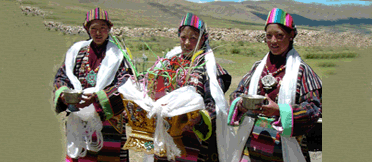
Tibet has very old and vast culture evolved from thousands of years back. It includes Buddhism, Tibetan art, Tibetan medicine Tibetan literature, Tibetan festivals, Tibetan food, Tibetan calendar, Tibetan clothing and khata, Tibetan music and Tibetan folktales, Tibetan architecture.
Tibetan civilization boasts a rich culture. Tibetan culture is greatly influenced by Tibetan Buddhism which is reflected through arts and ritual practices. Although Tibet has borrowed some cultural elements from its neighboring countries like India on rituals, china on food and Mongols on clothes but we have well adapted those elements in a unique way to suit the cold climate and high altitude of the Tibetan Plateau.
Tibetan wear Long and Dark coloured Chupas because they absorb more sunlight which is desirable in a cold region such as Tibet. Many Tibetans adorn their heads and hair with precious metals and minerals. Our staple food is Tsampa (roasted barley flour).
The Tibetan calendar is filled with many festivals. Losar, the Tibetan New Year celebration can last between 3 and 15 days. The majority of Tibetans are Buddhist and therefore are forbidden from harming animals, insects and all living things as well as trees, rivers and mountains. There are Tibetan Muslims, Hindus, Christians and non-believers in Tibet. The only Christian Church in Lhasa was maintained by the Tibetan Government until 1959 when the mission left Tibet permanently.
Since Tibetans are mostly nomads and farmers, many songs and dances are about them. Songs and dances related to marriage ceremonies and festivities are funny and witty. Beautiful songs about nature are common. Animal dances are performed as a demonstration of respect for a part of our global family. Opera is yet another favorite national pastime. Monks and high lamas have also composed many songs and dances
The Danger
Tibetan culture has evolved through time history. But it has never been faced with such a daunting challenge as it has today. Our culture is at its lowest ebb. The Chine's state is involved in social and cultural re-engineering. China decides what is right or wrong, good or bad, culture or civilized. Tibetans are reduced to minority status in their own home land. The Chinese language is forced upon Tibetans and the Tibetan language is not permitted to grow and enrich itself. Along with our language, Tibetan culture suffers
Some of the organisations committed to the preservation Tibetan culture areTibetan Cultural Preservation In Canada
JHAM Women’s group
RABSAL
Tibetan Cultural Institute of Arkansas
Tibet Online
(International Campaing for Tibet )
Rokpa
(C.T.A.C.C.T.C.)
Norbulingka Institute, Dharamsala
Amnye Machen Institute, Dharamsala
Conservancy For Tibetan Art & Culture, Washington, D.C.
Dansk Selskab For Tibetansk Kultur
Das Klosterliche Tibet - Institut Rikon
Estonian-Tibetan Cultural Society
Free Spirit
Himalayan Arts Project
Jacques Marchais Museum Of Tibetan Art
Khawa Karpo Tibet Culture Centre (Ktc)
Latse Library
Library Of Tibetan Works & Archives
Manjushree Center Of Tibetan Culture
Mechak Center For Contemporary Tibetan Art










Web designed and developed by: Tenzin Sherab (Longsho leader) with funding from National Endownment for Democracy (NED)

